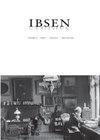Theatrical Adaptation of Ibsen’s An Enemy of the People in Iran: The Intellectual and Modernity in Akbar Radi’s The Decline
IF 0.1
0 THEATER
引用次数: 0
Abstract
The drama of Henrik Ibsen has been very influential in promoting social and realistic playwriting in Iranian theater since its introduction in the early twentieth century. Ibsen’s topoi of dysfunctional family connections, the woman question, enlightenment, to name a few have had a lasting impact on modern Iranian dramatists. In her study of Ibsen in Iranian theater, Farindokht Zahedi (2006) traces the arrival of the Norwegian playwright in Iran to the performance practice of Armenian troupes in northwestern Iran in the early twentieth century, particularly that of Hovans Abelian (1865–1936), who staged An Enemy of the People in Armenian in the city of Tabriz in 1909 to both Armenian and Iranian audiences. In a short span of time, Ibsen gained considerable prominence among Iranians and by the 1940s his plays were translated to and staged in Persian across the country, especially in the cities of Tabriz, Tehran, and Isfahan. A primary reason behind Ibsen’s warm reception among Iranians is that Ibsen’s social drama could offer Iranian playwrights and theater producers a critical engagement in the “cultural and social circumstances” of their contemporary society (May 1985, 30). This Iranian reception coincided with a faltering economy and poverty as the result of dramatic changes in civil and political structures. A significant factor in cultural change易卜生《伊朗人民的敌人》的戏剧改编——阿克巴尔·拉迪《衰落》中的知识分子与现代性
易卜生戏剧自二十世纪初传入伊朗以来,在促进伊朗戏剧的社会现实主义创作方面具有重要影响。易卜生关于家庭关系失调、女性问题、启蒙等的小说对现代伊朗剧作家产生了持久的影响。Farindokht Zahedi(2006)在她对伊朗戏剧中易卜生的研究中,将挪威剧作家来到伊朗追溯到二十世纪初伊朗西北部亚美尼亚剧团的表演实践,特别是霍万斯·阿贝良(1865–1936),他于1909年在大不里士市用亚美尼亚语向亚美尼亚和伊朗观众上演了《人民的敌人》。在很短的时间内,易卜生在伊朗人中获得了相当大的声望,到20世纪40年代,他的戏剧被翻译成波斯语,并在全国各地上演,尤其是在大不里士、德黑兰和伊斯法罕等城市。易卜生在伊朗人中受到热烈欢迎的一个主要原因是,易卜生的社会戏剧可以为伊朗剧作家和戏剧制作人提供对当代社会“文化和社会环境”的批判性参与(1985年5月,30日)。伊朗受到欢迎的同时,由于公民和政治结构的急剧变化,经济和贫困也在衰退。文化变化的一个重要因素
本文章由计算机程序翻译,如有差异,请以英文原文为准。
求助全文
约1分钟内获得全文
求助全文

 求助内容:
求助内容: 应助结果提醒方式:
应助结果提醒方式:


